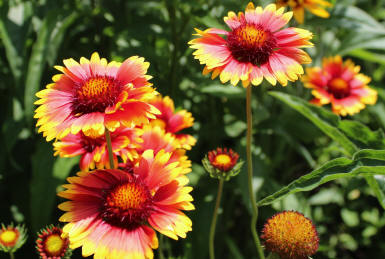(7/6) A perennial plant is one that lives for at least three years. Technically trees, shrubs, and some vines are perennial because they live for multiple years, but they are generally referred to as woody plants.
When gardeners talk about perennial plants, they are generally referring to herbaceous perennials. The plant itself will die off during the winter, but the root area, or crown, is very much alive. Usually, a small cluster of leaves called a rosette will appear on top of the crown, and the plant will grow up from there.
When selecting a new perennial for your garden, pay attention to the hardiness zone which is always printed on the plant tag. We are zone 6. Any plant marked zone 7 or above will freeze over the winter in our area. A plant marked zone.6 or lower should survive our winters just fine.
After a perennial plant has produced its flowers, the petals will die off leaving behind what we call a seed head. Some gardeners feel these look messy and like to cut them off. In many cases, leaving the seed head will lead to seedlings appearing in your garden next year. Birds appreciate it if you leave seed heads because they eat the seeds during the winter,
especially from native plants.
Some perennial plants will continue to bloom longer if you deadhead them, meaning you cut off the spent flowers. However, there are many plants that just give you a great show for a couple weeks, then pack it away until next year.
Because perennials have a Iimited bloom period, some gardeners bemoan the fact that their garden lacks color by late summer. To remedy this situation, you have to revisit the nursery in the summer and fall. Many perennials that develop and bloom later in the season are barely visible in May, so the retailers hold them for later display.
Most people buy their perennials from a nursery. Few gardeners realize that they can grow many perennials from seed and save a lot of money.
 A perennial takes longer to establish itself than an annual, which lives only one year. Many perennial seeds need a long period of cold in order to germinate. The secret to growing a perennial from seed is to start the seeds sometime between June and November. Instead of starting them inside, it is actually
best to start them outside in pots, or in some protected area directly in the ground where their growing conditions will be as natural as possible. You should have flowers by the next summer
A perennial takes longer to establish itself than an annual, which lives only one year. Many perennial seeds need a long period of cold in order to germinate. The secret to growing a perennial from seed is to start the seeds sometime between June and November. Instead of starting them inside, it is actually
best to start them outside in pots, or in some protected area directly in the ground where their growing conditions will be as natural as possible. You should have flowers by the next summer
Two ways to get more free perennials for your garden include divisions and cuttings, either from your own garden, or from a friend's. Many perennials will start out as a small plant, then, each year the clump will get larger and larger. If you inspect that clump closely, you will see that it is actually composed of many small plants. You can easily divide this plant by
digging up the entire clump, and breaking it into multiple pieces, or simply by digging out a piece of the large clump. Coneflowers, Shasta Daisies, Black Eyed Susan, and Day Lilies are examples of common garden perennials that are easily divided. The best and easiest times to divide any plant is either in the Spring before it puts on its full growth, or in the Fall after
you cut off the top.
Two popular plants that will respond well to cuttings are Lavender and Coleus, but you can take cuttings from almost any plant. Begin with a clean, sharp knife. Measure about six inches of fairly new growth. Notice where a leaf is attached to the stem, then go down about one half inch, and slice the stem on an angle. Strip off any bottom leaves that would go into the
water or soil, then treat the end of the stem with a planting hormone such as Rootone rooting powder. Immediately, place the cutting in water or other damp potting medium. A neat reason to use water is that you can see when the roots begin to form.
Once the plant has a good root system, you can transfer it to soil. Use a pencil to make a hole in the soil large enough to accommodate the roots so you won't break them off as you insert them. Soon you will see new leaves begin to form, and, like magic, you now have a new plant!
One of the lessons learned from gardening is patience. Taking cuttings and planting seeds is a slower way to add to your garden, but it is far less expensive, if not free! The best part is that it opens up a whole new side of gardening you may not have tried before.
Once you have your perennials growing, keeping them neat will enhance the beauty of your garden. Don't be afraid to cut off parts that no longer look nice. If the whole plant looks bad, cut it off. It will probably come right back looking fresh and healthy. If it doesn't come back this year, it will be back next year, and in the meantime it is no longer an eyesore in
your garden.